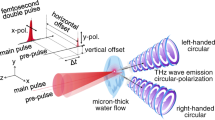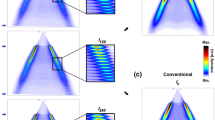Abstract
This study aims to investigate the effect of laser sheet orientation on the OH-planar laser-induced fluorescence (OH-PLIF) imaging of a detonation wave and to identify the potential benefit of using a transverse laser orientation, compared to the conventional frontal orientation. In this study, we developed a new laser-induced fluorescence (LIF) model, based on a preexisting one, to include a more fundamental calculation of the absorption lineshape and the effects of the laser orientation on the fluorescence signal. One- and two-dimensional simulations are used to validate this new LIF model for both laser orientations using OH-PLIF images from the literature. The effect of the two laser orientations on detonation imaging is investigated numerically on a two-dimensional OH field. Based on these results, the frontal orientation seems more suitable to collect information near the detonation front, while the transverse laser orientation can give more quantitative information far from the front and only for short optical paths. With the present laser configuration and experimental conditions, both laser orientations present the same limitation with a strong laser energy absorption for long optical paths. While these first results show a qualitative agreement with experimental data, new experimental data are required to quantitatively validate this promising transverse laser orientation and confirm its relevance for OH-PLIF imaging of detonations.









Similar content being viewed by others
References
Austin, J.M.: The role of instability in gaseous detonation. Ph.D thesis, California Institute of Technology (2003)
Pintgen, F.: Laser-optical visualization of detonation structures. Master thesis, Technische Universität München (2000)
Pintgen, F., Eckett, C.A., Austin, J.M., Shepherd, J.E.: Direct observations of reaction zone structure in propagating detonations. Combust. Flame 133(3), 211–229 (2003). https://doi.org/10.1016/S0010-2180(02)00458-3
Austin, J.M., Pintgen, F., Shepherd, J.E.: Reaction zones in highly unstable detonations. Proc. Combust. Inst. 30(2), 1849–1857 (2005). https://doi.org/10.1016/j.proci.2004.08.157
Li, L., Li, J.M., van Nguyen, B., Teo, C.J., Chang, P.H., Khoo, B.C.: A study of detonation re-initiation through multiple reflections in a 90-degree bifurcation channel. Combust. Flame 180, 207–216 (2017). https://doi.org/10.1016/j.combustflame.2017.03.004
Li, L.: Reflected re-initiation of gaseous detonation. Ph.D thesis, National University of Singapore (2017)
Radulescu, M.I.: A detonation paradox: why inviscid detonation simulations predict the incorrect trend for the role of instability in gaseous cellular detonations? Combust. Flame 195, 151–162 (2018). https://doi.org/10.1016/j.combustflame.2018.05.002
Mével, R., Davidenko, D., Austin, J.M., Pintgen, F., Shepherd, J.E.: Application of a laser induced fluorescence model to the numerical simulation of detonation waves in hydrogen–oxygen–diluent mixtures. Int. J. Hydrog. Energy 39(11), 6044–6060 (2014). https://doi.org/10.1016/j.ijhydene.2014.01.182
Mével, R., Davidenko, D., Lafosse, F., Chaumeix, N., Dupré, G., Paillard, C.É., Shepherd, J.E.: Detonation in hydrogen–nitrous oxide–diluent mixtures: an experimental and numerical study. Combust. Flame 162(5), 1638–1649 (2015). https://doi.org/10.1016/j.combustflame.2014.11.026
Mével, R.: Optical regime diagram of the shock tube/pulsed laser-induced fluorescence imaging technique. Chem. Phys. Lett. 730, 283–288 (2019). https://doi.org/10.1016/j.cplett.2019.06.009
Eder, A.: Brennverhalten schallnaher und überschall-schneller Wasserstoff-Luft Flammen. Ph.D thesis, Technische Universität München (2001)
Lee, S.Y., Watts, J., Saretto, S., Pal, S., Conrad, C., Woodward, R., Santoro, R.: Deflagration to detonation transition processes by turbulence-generating obstacles in pulse detonation engines. J. Propul. Power 20(6), 1026–1036 (2004). https://doi.org/10.2514/1.11042
Wang, C., Xu, S., Fei, L.: Study on reaction zone structure of gaseous detonation wave by planar laser induced fluorescence technique. Chin. J. Theor. Appl. Mech. 23(5), 661–667 (2007). https://doi.org/10.6052/0459-1879-2007-5-2005-639
Bessler, W.G., Schulz, C., Sick, V., Daily, J.W.: A versatile modeling tool for nitric oxide LIF spectra. Proceedings of the Third Joint Meeting of the US Sections of The Combustion Institute, P105 (2003)
Hanson, R.K., Mitchell Spearrin, R., Goldenstein, C.S.: Spectroscopy and Optical Diagnostics for Gases. Springer, Berlin (2016). https://doi.org/10.1007/978-3-319-23252-2
Gordon, I.E., Rothman, L.S., Hill, C., Kochanov, R.V., Tan, Y., Bernath, P.F., Birk, M., Boudon, V., Campargue, A., Chance, K.V., Drouin, B.J., Flaud, J.M., Gamache, R.R., Hodges, J.T., Jacquemart, D., Perevalov, V.I., Perrin, A., Shine, K.P., Smith, M.A., Tennyson, J., Toon, G.C., Tran, H., Tyuterev, V.G., Barbe, A., Császár, A.G., Devi, V.M., Furtenbacher, T., Harrison, J.J., Hartmann, J.M., Jolly, A., Johnson, T.J., Karman, T., Kleiner, I., Kyuberis, A.A., Loos, J., Lyulin, O.M., Massie, S.T., Mikhailenko, S.N., Moazzen-Ahmadi, N., Müller, H., Naumenko, O.V., Nikitin, A.V., Polyansky, O.L., Rey, M., Rotger, M., Sharpe, S.W., Sung, K., Starikova, E., Tashkun, S.A., Auwera, J.V., Wagner, G., Wilzewski, J., Wcisło, P., Yu, S., Zak, E.J.: The HITRAN2016 molecular spectroscopic database. J. Quant. Spectrosc. Radiat. Transf. 203, 3–69 (2017). https://doi.org/10.1016/j.jqsrt.2017.06.038
Thiery, L., Prenel, J.P., Porcar, R.: Theoretical and experimental intensity analysis of laser light sheets for flow visualization. Opt. Commun. 123, 801–809 (1996). https://doi.org/10.1016/0030-4018(95)00523-4
Mével, R., Javoy, S., Lafosse, F., Chaumeix, N., Dupré, G., Paillard, C.E.: Hydrogen-nitrous oxide delay times: shock tube experimental study and kinetic modelling. Proc. Combust. Inst. 32(1), 359–366 (2009). https://doi.org/10.1016/j.proci.2008.06.171
Mével, R., Sabard, J., Lei, J., Chaumeix, N.: Fundamental combustion properties of oxygen enriched hydrogen/air mixtures relevant to safety analysis: experimental and simulation study. Int. J. Hydrog. Energy 41(16), 6905–6916 (2016). https://doi.org/10.1016/j.ijhydene.2016.03.026
Davidenko, D., Mével, R., Dupré, G.: Numerical study of the detonation structure in rich \(\text{ H}_{2}-\text{ NO}_{2}/\text{N}_{2}\text{ O}_{4}\) and very lean \(\text{ H}_{2}-\text{ N}_{2}\text{ O }\) mixtures. Shock Waves 21(2), 85–99 (2011). https://doi.org/10.1007/s00193-011-0297-z
Gallier, S., Le Palud, F., Pintgen, F., Mével, R., Shepherd, J.E.: Detonation wave diffraction in \(\text{ H}_{2}-\text{ O}_{2}-\text{ Ar }\) mixtures. Proc. Combust. Inst. 36(2), 2781–2789 (2017). https://doi.org/10.1016/j.proci.2016.06.090
Shepherd, J.E.: Chemical kinetics of hydrogen–air–diluent detonations. Prog. Astronaut. Aeronaut. 106, 263–293 (1986)
Browne, S., Zeigler, J., Shepherd, J.E.: Numerical solution methods for shock and detonation jump conditions. Technical report FM2006-006, Graduate Aeronautical Laboratories California Institute of Technology (2008)
Mével, R.: Etude de mécanismes cinétiques et des propriétés explosives des systèmes hydrogène-protoxyde d’azote et silane-protoxyde d’azote: application à la sécurité industrielle. Ph.D thesis, Université d’Orléans (2009). http://www.theses.fr/2009ORLE2068. Accessed 29 Nov 2019
Mével, R., Gallier, S.: Structure of detonation propagating in lean and rich dimethyl ether–oxygen mixtures. Shock Waves 28(5), 955–966 (2018). https://doi.org/10.1007/s00193-018-0837-x
Reynaud, M., Virot, F., Chinnayya, A.: A computational study of the interaction of gaseous detonations with a compressible layer. Phys. Fluids 29(5), 056101 (2017). https://doi.org/10.1063/1.4982659
Taileb, S., Melguizo-Gavilanes, J., Chinnayya, A.: Chemistry modeling effects on the interaction of a gaseous detonation with an inert layer. 27th International Colloquium on the Dynamics of Explosions and Reactive Systems, Beijing, Paper 320 (2019)
Savard, B., Xuan, Y., Bobbitt, B., Blanquart, G.: A computationally-efficient, semi-implicit, iterative method for the time-integration of reacting flows with stiff chemistry. J. Comput. Phys. 295, 740–769 (2015). https://doi.org/10.1016/j.jcp.2015.04.018
Sow, A., Chinnayya, A., Hadjadj, A.: On the viscous boundary layer of weakly unstable detonations in narrow channels. Comput Fluids 30, 449–458 (2019). https://doi.org/10.1016/j.compfluid.2018.11.006
Sharpe, G.J.: Transverse waves in numerical simulations of cellular detonations. J. Fluid Mech. 447, 31–51 (2001). https://doi.org/10.1017/S0022112001005535
Acknowledgements
Research reported in this publication was supported by the King Abdullah University of Science and Technology (KAUST). RM was supported by the 1000 Young Talent of China program, a start-up fund of the Center for Combustion Energy of Tsinghua University, and the 1000 Young Talent Matching Fund from Tsinghua University. The computations were performed using HPC resources from the cluster of Pprime, the Mésocentre de Calcul Poitevin and from GENCI-CINES (Grant 2018-A0052B07735). This work was supported by the CPER FEDER Project of Région Nouvelle Aquitaine. The authors are grateful to Joanna M. Austin for allowing the use of her experimental OH-PLIF image in Fig. 3.
Author information
Authors and Affiliations
Corresponding author
Ethics declarations
Conflict of interest
The authors declare that they have no conflict of interest.
Additional information
Communicated by G. Ciccarelli.
Publisher's Note
Springer Nature remains neutral with regard to jurisdictional claims in published maps and institutional affiliations.
This paper is based on work that was presented at the 27th International Colloquium on the Dynamics of Explosions and Reactive Systems, Beijing, China, July 28–August 2, 2019.
Electronic supplementary material
Below is the link to the electronic supplementary material.
Supplementary material 1 (avi 5999 KB)
Appendices
Appendix 1: Sequence of images of the Voigt profile evolution along the detonation front
This appendix presents (Fig. 9) a more detailed evolution of the Voigt profiles presented in Fig. 1, with a higher spatial resolution to better illustrate the absorption lineshape evolution along the distance behind the leading shock (X). Similarly to the results presented in Fig. 1, the absorption lines are simulated based on Wang et al.’s [13] experimental conditions with a transverse laser orientation (\(\delta _{\text {D}}=0\) and \(\delta _{\text {Tot.}}=\delta _\mathrm{P}\)). A movie presenting this sequence of images with intermediate positions is available in the supplementary material.
Appendix 2: Additional 1D validation cases with the transverse laser orientation.
Figure 10 presents two additional 1D validation cases extracted from Wang et al.’s OH-PLIF image [13]. As presented for areas 1 and 2, the LIF model reproduces qualitatively the overall intensity profile for both areas 3 and 4 when the correction accounting for the saturation of the camera is included. In area 3, the fluorescence decay has an overall offset of 2 mm, which is relatively small considering the non-ideality in the experimental image (the tilted detonation front). In area 4, the double peak structure is reproduced in the simulation with a local fluorescence intensity minimum located near 2 mm as observed experimentally. The double peak intensity is underestimated by 25% in area 4; this might indicate that the fluorescence signal attenuation is overestimated in the current model, or this might be due to an overestimated laser intensity attenuation. As discussed in Sect. 3.1 and emphasized in the conclusions, new experimental data are required to fully validate the LIF model for the transverse laser orientation.
1D validation of the transverse laser orientation using an OH-PLIF image from Wang et al. [13], shown in a. 1D experimental (black symbols) and ZND (red and green lines) LIF profiles, obtained for area 3 and 4, are respectively shown in b and c. ZND OH mole fractions (blue lines) are represented for comparison. Conditions: 2H\(_{2}\)–O\(_{2}\)–10Ar at \(P_{1}\) = 45.3 kPa and \(T_{1}\) = 295 K
Effect of the laser sheet orientation on the absorption line shifts in Wang et al.’s conditions [13]. Conditions: 2H\(_{2}\)–O\(_{2}\)–10Ar at \(P_{1}\) = 45.3 kPa and \(T_{1}\) = 295 K
Effect of the initial pressure on the absorption lineshapes in Wang et al.’s experimental conditions [13] with a frontal laser orientation. Conditions: 2H\(_{2}\)–O\(_{2}\)–10Ar at \(T_{1}\) = 295 K and both \(P_{1}\) = 45.3 kPa and \(P_{1}\) = 100 kPa shown, respectively, in a and b
Appendix 3: Relevance of the new LIF model
This appendix demonstrates the need to develop the new LIF model and to consider the improvements presented in this work, notably the absorption line shifts and the Voigt profile calculation. As explained in Sect. 3.2, the two laser orientations (the transverse and the frontal) must be considered independently as the Doppler shift is significantly different for these two orientations. Only three characteristic distances from the detonation front are presented in Figs. 11 and 12: von Neumann state (\(X_{\text {vN}}\)), induction length (\(\varDelta _\mathrm{i}\)), and CJ state (\(X_{\text {CJ}}\)).
Figure 11 emphasizes the contribution of the Doppler shift (\(\delta _{\text {D}}\)) for Wang et al.’s conditions, for both the two- and the five-line calculations of the Voigt profile. As the laser linecenter is constant, the \(\delta _{\text {D}}\) contribution is observed by comparing the shift of the Voigt profile maximum with the laser linecenter between Fig. 11a and b for the three positions. As the value of \(\delta _{\text {D}}\) decreases with the distance behind the leading shock and is mainly contributing to \(\delta _{\text {Tot.}}\), it must be noted that the shift is the strongest for \(X_{\text {vN}}\).
Figure 12 presents the evolution of both the two- and the five-line calculations of the Voigt profile at two different pressure conditions using a frontal laser orientation and for the three distances from the detonation front, defined previously: \(X_{\text {vN}}\), \(\varDelta _\mathrm{i}\), and \(X_{\text {CJ}}\).
These figures show the need to consider the contribution of additional absorption lines for higher initial pressure in this specific spectral range.
Rights and permissions
About this article
Cite this article
Chatelain, K.P., Mével, R., Melguizo-Gavilanes, J. et al. Effect of incident laser sheet orientation on the OH-PLIF imaging of detonations. Shock Waves 30, 689–702 (2020). https://doi.org/10.1007/s00193-020-00963-y
Received:
Revised:
Accepted:
Published:
Issue Date:
DOI: https://doi.org/10.1007/s00193-020-00963-y







